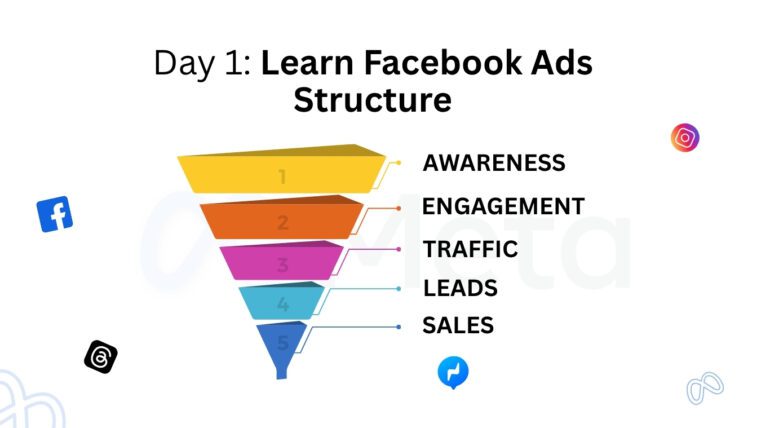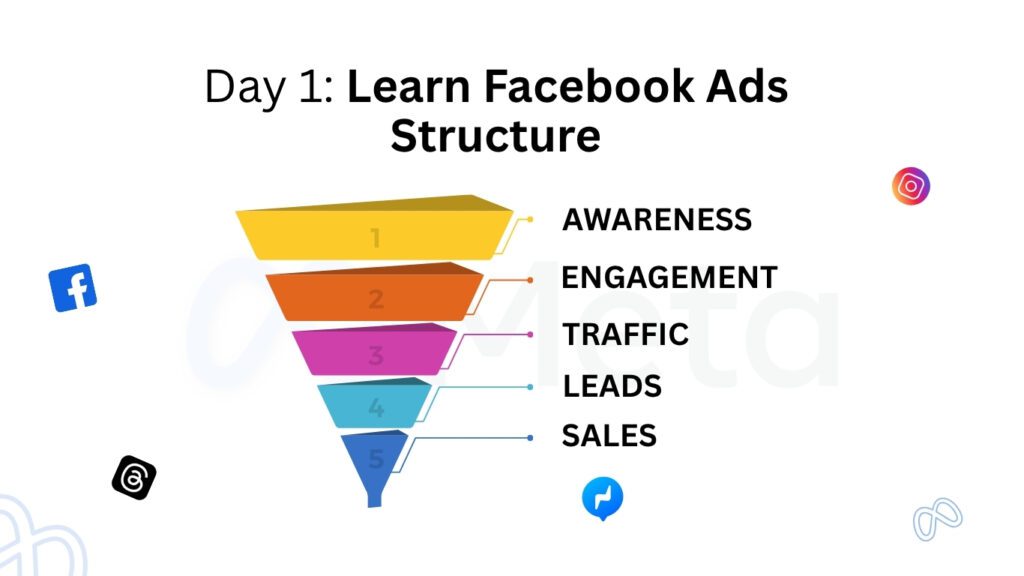

Day 1: Learn Facebook Ads Structure (Campaign > Ad Set > Ad)
Facebook Ads can be one of the most powerful tools in your marketing arsenal, when you understand how to use them correctly. But before diving into strategies, creatives, audiences, budgets, and analytics, there’s a fundamental concept you must fully grasp: the Facebook Ads Structure.
Understanding the Campaign > Ad Set > Ad hierarchy is like learning the grammar of a new language. Without it, everything else will feel confusing. With it, everything else begins to make sense. So today, we focus entirely on this structure, why it matters, and how to work within it confidently.
1. What Is the Facebook Ads Structure?

At its core, Facebook Ads are organized into three layers:
- Campaign (the objective layer)
- Ad Set (the strategy layer)
- Ad (the creative layer)
Each of these levels plays a distinct and essential role in building an effective advertising effort. Let’s explore what happens at each level and how they connect.
2. Campaign: The Objective Layer

The campaign is the topmost level in the Facebook Ads hierarchy. It defines your goal. What do you want your ad to accomplish?
Purpose:
Your campaign answers the question:
What do you want people to do when they see your ad?
Facebook/Meta allows you to choose from several objectives, including:
- Awareness (Brand awareness, Reach)
- Traffic (Drive people to your website or app)
- Engagement (Page likes, event responses, post engagement)
- Leads (Lead generation forms, instant forms, conversions)
- App Promotion (Drive app installs and interactions)
- Sales (Conversions, catalog sales, store traffic)
For example, if your goal is to get people to visit your website, you’d select the Traffic objective. If your goal is to generate leads, you’d choose Leads.
Key Campaign Features:
- Objective selection (critical for ad delivery optimization)
- Campaign Budget Optimization (CBO), if used
- Buying type (Auction or Reach & Frequency)
3. Ad Set: The Strategy Layer
Inside each campaign, you can create one or more Ad Sets. This is where the strategic decisions are made. If the campaign is your destination, the ad set is your roadmap.
Purpose:
Your ad set defines who sees your ad, where they see it, and when.
Ad Set Settings Include:
- Audience:
- Custom Audiences
- Lookalike Audiences
- Interest-based targeting
- Demographics (age, gender, location, etc.)
- Placements:
- Automatic placements (Facebook, Instagram, Audience Network, Messenger)
- Manual placements (news feed only, stories only, etc.)
- Budget & Schedule:
- Daily or lifetime budget
- Start/end dates
- Ad delivery optimization (clicks, conversions, impressions)
You can have multiple ad sets within a campaign, each targeting different audiences or placements. This allows you to test different strategies under one objective.
Example:
- Campaign Objective: Sales
- Ad Set 1: Women aged 25-35, Instagram only
- Ad Set 2: Men aged 30-45, Facebook only
4. Ad: The Creative Layer
Finally, inside each ad set, you’ll create the actual ads, the visual and textual content that users will see.
Purpose:
Your ad answers the question:
What message are you delivering, and how are you delivering it?
Creative Elements:
- Format: Single image, carousel, video, slideshow, collection
- Copy:
- Primary text
- Headline
- Description
- Call-to-action (CTA) button (Shop Now, Learn More, etc.)
- Media:
- Images or videos
- Landing page URL
Each ad must match the intent of the ad set audience and campaign objective. Good ad creatives resonate emotionally, visually, and contextually with your target audience.
5. Why This Structure Matters
Understanding the Facebook Ads structure is not just a technical necessity, it’s a strategic advantage. Here’s why:
Clarity & Control
Each level of the structure serves a different role. Knowing how to control and separate them allows you to manage your campaigns with surgical precision.
Easier Testing
You can test multiple ad sets under one campaign or multiple ads under one ad set. This enables A/B testing across targeting, placements, and creatives.
Better Optimization
Facebook’s algorithm performs better when it understands your objective clearly. Setting the right campaign goals and structuring your ad sets accordingly improves delivery and lowers cost-per-result.
Clean Account Organization
As your ad account grows, a structured approach ensures better organization. You avoid chaos and confusion when managing dozens, or even hundreds, of campaigns.
6. Real-World Analogy
Let’s think of the Facebook Ads structure like a movie production:
- Campaign = The Movie Genre
- Are we making a comedy, drama, action, or horror movie? This sets the tone and direction.
- Ad Set = The Script & Cast
- Who are we targeting? What’s the setting? When is it being released?
- Ad = The Final Scene
- This is the finished product, what the audience actually sees on screen.
Would you shoot a movie without knowing the genre or script? That’s what running ads without structure feels like.
7. Common Mistakes When Learning Facebook Ads Structure
Let’s address some pitfalls beginners face:
❌ Mistake 1: Ignoring the Hierarchy
Creating ads without understanding which level controls what leads to poor results and wasted budgets.
❌ Mistake 2: Mixing Objectives
Don’t use multiple objectives in one campaign. Keep campaigns clean and focused on one goal.
❌ Mistake 3: Skipping Audience Strategy
Dumping everything into one ad set limits your ability to test audiences effectively.
❌ Mistake 4: Poor Ad Organization
Name your campaigns, ad sets, and ads clearly. Use labels like:
[Sales] – Lookalike Audience – US Women 25-35
[LeadGen] – Custom Website Visitors – Mobile Only
8. Practical Exercise for Day 1
To solidify your learning, do this today:
Step 1: Open Meta Ads Manager
Head to https://www.facebook.com
Step 2: Create a Dummy Campaign
Even if you don’t publish it, go through the motions:
- Choose a Campaign Objective (e.g., Traffic)
- In the Ad Set, select an audience and placement
- Create an Ad with a sample image or video
Step 3: Name Everything Properly
Practice naming like a pro:
- Campaign: Day1_Traffic_LearnAdsStructure
- Ad Set: Interest_Marketing_India_MobileOnly
- Ad: Image1_HeadlineA_CTA1
Step 4: Repeat the Hierarchy Verbally
Say it out loud:
Campaign > Ad Set > Ad
Repeat this throughout the day. Make it second nature.
9. Expert Tip: Keep Each Level Clean
A good practice is to separate tests cleanly:
- Want to test audiences? Keep the ad and campaign the same, and change the ad set.
- Want to test creatives? Keep the campaign and ad set the same, and change the ad.
- Want to test objectives? Create a new campaign.
This structure allows you to draw clearer insights from results.
10. Visual Summary of Facebook Ads Structure
Campaign (Objective: Sales)
├── 📂 Ad Set 1 (Audience: India, Interests: Fitness)
│ ├── 🎨 Ad 1 (Video of workout)
│ └── 🎨 Ad 2 (Image of product)
└── 📂 Ad Set 2 (Audience: USA, Interests: Yoga)
├── 🎨 Ad 3 (Testimonial video)
└── 🎨 Ad 4 (Lifestyle image)
11. Reflection: Why Learning This Changes Everything
After today, you’ll no longer be guessing why your ads fail or succeed. You’ll be able to isolate problems, test intentionally, and scale successfully.
Think of Day 1 as laying the foundation of your Meta Ads career. All advanced strategies build on this structure, from retargeting to lookalikes, A/B testing to scaling. It all ties back to Campaign > Ad Set > Ad.
12. What’s Next on Day 2?
Now that you understand the structure, tomorrow we’ll move to setting Campaign Objectives strategically, because knowing what you want is just as important as knowing how to ask for it.
What happens if I change the campaign objective after publishing?
